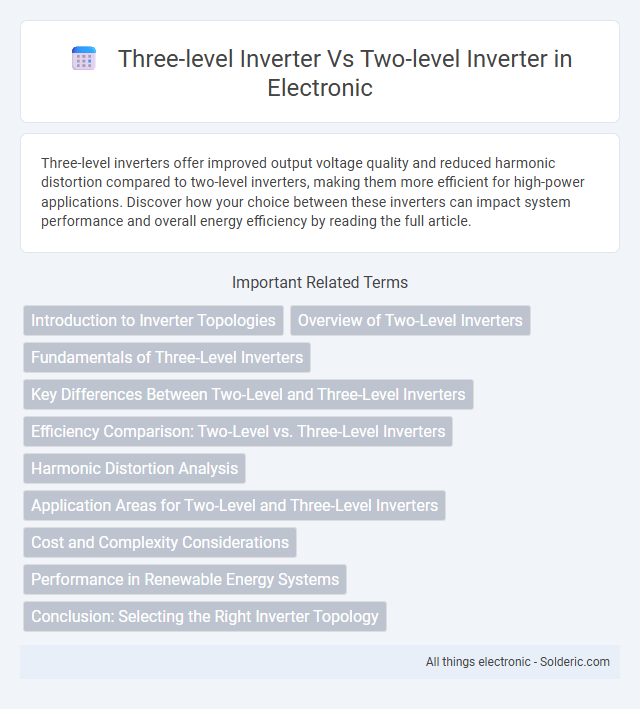Three-level inverters offer improved output voltage quality and reduced harmonic distortion compared to two-level inverters, making them more efficient for high-power applications. Discover how your choice between these inverters can impact system performance and overall energy efficiency by reading the full article.
Comparison Table
| Feature | Three-Level Inverter | Two-Level Inverter |
|---|---|---|
| Voltage Levels | Three (positive, zero, negative) | Two (positive, negative) |
| Output Waveform Quality | Higher quality, reduced harmonic distortion | Lower quality, higher harmonic distortion |
| Switching Frequency | Lower, reduces switching losses | Higher, increased switching losses |
| Power Rating | Suitable for medium to high power applications | Typically used in low to medium power applications |
| Efficiency | Higher efficiency due to lower losses | Lower efficiency |
| Complexity | More complex design and control | Simpler design and control |
| Cost | Higher initial cost | Lower initial cost |
| Applications | Renewable energy, industrial drives, high power systems | Standard motor drives, low power converters |
Introduction to Inverter Topologies
Three-level inverters utilize three voltage levels to enhance power quality and reduce harmonic distortion compared to traditional two-level inverters, which switch between just two voltage states. The multi-level topology in three-level inverters allows for smoother voltage steps, leading to improved efficiency and lower electromagnetic interference in high-power applications. These advantages make three-level inverters highly suitable for renewable energy systems and medium-voltage motor drives where precise voltage control is critical.
Overview of Two-Level Inverters
Two-level inverters convert DC voltage directly into a two-level AC output, switching between positive and negative voltage levels to create a PWM waveform. They simplify control and have lower switching complexity compared to multi-level inverters, but generate higher harmonic distortion and voltage stress on power devices. Widely used in low to medium power applications, two-level inverters are cost-effective and reliable for less demanding power quality requirements.
Fundamentals of Three-Level Inverters
Three-level inverters utilize three voltage levels to produce output waveforms with lower total harmonic distortion (THD) compared to two-level inverters, improving power quality and efficiency. The fundamental operation of three-level inverters involves switching devices configured to generate neutral-point voltage levels, enabling smoother voltage transitions and reduced electromagnetic interference. This topology is especially beneficial in high-power applications such as renewable energy systems and motor drives where enhanced waveform quality and reduced filter size are critical.
Key Differences Between Two-Level and Three-Level Inverters
Three-level inverters provide improved output voltage quality and reduced harmonic distortion compared to two-level inverters by using an additional voltage level, which leads to smoother waveform transitions. They offer enhanced efficiency and lower electromagnetic interference, making them ideal for high-power applications where precise control and reliability matter. Your choice between two-level and three-level inverters depends on application requirements, including power quality, system complexity, and cost considerations.
Efficiency Comparison: Two-Level vs. Three-Level Inverters
Three-level inverters generally offer higher efficiency than two-level inverters due to reduced switching losses and improved voltage waveform quality, which minimizes harmonic distortion. The multi-level topology allows for lower voltage stress on power devices, resulting in enhanced thermal performance and longer component lifespan. Consequently, three-level inverters provide better overall efficiency in medium to high power applications, making them suitable for renewable energy systems and industrial drives.
Harmonic Distortion Analysis
Three-level inverters significantly reduce Total Harmonic Distortion (THD) compared to two-level inverters by incorporating an additional voltage level that smooths output waveforms and decreases switching frequency harmonics. This improvement in harmonic profile enhances power quality and reduces the need for complex filtering, leading to better system efficiency and extended equipment lifespan. When optimizing your inverter choice for sensitive applications, three-level designs offer superior harmonic distortion performance.
Application Areas for Two-Level and Three-Level Inverters
Two-level inverters are widely applied in low to medium power industrial drives, renewable energy systems like solar photovoltaic inverters, and uninterruptible power supplies (UPS) due to their simple design and cost-effectiveness. Three-level inverters find extensive use in high-power applications such as medium-voltage motor drives, grid-tied wind turbines, and flexible AC transmission systems (FACTS) because of their improved waveform quality, lower harmonics, and reduced switching losses. Both inverter types serve critical roles in power conversion, but three-level inverters are preferred where enhanced efficiency and voltage handling are required.
Cost and Complexity Considerations
Three-level inverters typically incur higher initial costs due to the increased number of power semiconductor devices and more complex gate-drive circuits compared to two-level inverters. The complexity of three-level inverter control algorithms and associated hardware requirements also leads to greater design and maintenance efforts. In contrast, two-level inverters offer simpler topologies and lower manufacturing costs, making them more favorable for cost-sensitive applications.
Performance in Renewable Energy Systems
Three-level inverters offer superior harmonic reduction and improved voltage quality compared to two-level inverters, enhancing the efficiency and reliability of renewable energy systems such as solar and wind power plants. Their ability to produce output voltages closer to sinusoidal waveforms reduces filtering requirements and minimizes power losses, leading to higher energy conversion efficiency. In renewable applications, three-level inverters provide better thermal management and longer device lifespan, supporting stable grid integration and optimized system performance under varying load conditions.
Conclusion: Selecting the Right Inverter Topology
Three-level inverters offer improved output waveform quality and reduced harmonic distortion compared to two-level inverters, enhancing efficiency for high-power applications. Two-level inverters provide simplicity and lower cost, making them suitable for low to medium power systems with less stringent performance requirements. Selecting the right inverter topology depends on balancing factors like power rating, efficiency demands, cost constraints, and application-specific performance criteria.
three-level inverter vs two-level inverter Infographic

 solderic.com
solderic.com